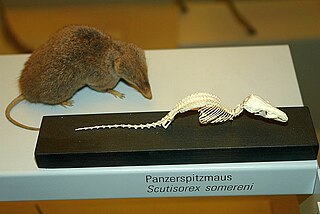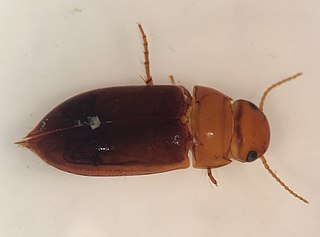
Mysidae is the largest family of crustaceans in the order Mysida, with over 1000 species in around 170 genera.
Stylocheiron is a genus of krill, containing the following species:
Giuseppe Colosi was an Italian zoologist. He specialized in the study of crustaceans and mysids in particular.

Tube-dwelling anemones or ceriantharians look very similar to sea anemones but belong to an entirely different subclass of anthozoans. They are solitary, living buried in soft sediments. Tube anemones live inside and can withdraw into tubes, which are composed of a fibrous material made from secreted mucus and threads of nematocyst-like organelles known as ptychocysts. Within the tubes of these ceriantharians, more than one polyp is present, which is an exceptional trait because species that create tube systems usually contain only one polyp per tube. Ceriantharians were formerly classified in the taxon Ceriantipatharia along with the black corals but have since been moved to their own subclass, Ceriantharia.

Scutisorex is a genus of African shrews, mammals of the family Soricidae. Members of the genus are the only known mammal species whose vertebrae interlock, a feature which, along with the general enlargement and strengthening of the backbone and ribs, allows them to bear remarkable loads. They also have well developed muscles for flexing their spine in the sagittal plane. It is thought that these adaptations allow the shrews to wedge open spaces between the trunks of palm trees and the stems of dead leaves, as well underneath logs and rocks, allowing them to partake of a reliable source of insect larvae and earthworms that would otherwise be inaccessible.

Hippolyte is a genus of shrimp of the family Hippolytidae, containing the following species:
Afrithelphusa is a genus of freshwater crabs in the family Potamonautidae. It contains four species, all of which were formerly listed as critically endangered by the International Union for Conservation of Nature (IUCN). They are all endemic to the Upper Guinean forests of Guinea and Sierra Leone.

Potamonautes is a genus of African freshwater crabs in the family Potamonautidae. It is both the most widespread and most diverse genus of African freshwater crabs, including more than half the species of this continent. They are found in most freshwater habitats of the African mainland and some species are semi-terrestrial.

Halichondria is a genus of sea sponges belonging to the family Halichondriidae. These are massive, amorphous sponges with clearly separated inner and outer skeletons consisting of bundles of spicules arranged in a seemingly random pattern.

Paramysis is a genus of mysid crustaceans (Mysidacea) in family Mysidae, distributed in coastal zone of low boreal East Atlantic Ocean, Mediterranean Sea and the basins of Black Sea, Sea of Azov and Caspian Sea.
Acanthomysis is a genus of mysids, containing 28 species.

Paramysis baeri is a species of mysid crustacean from the genus Paramysis, named in honour of the prominent biologist Karl Ernst von Baer. Its body is 13–31 millimetres (0.51–1.22 in) long, and it is only found in the coastal waters of the Caspian Sea, on sandy and muddy bottoms, at depths of less than 20 m (66 ft). For over a century, it was thought to be distributed throughout the whole Ponto-Caspian basin, but recently the range was reconsidered after the rediscovery and re-establishment of the closely related species Paramysis bakuensis. Since the taxonomical status of P. baeri has been reconsidered, the distribution and ecology of the species remains poorly known. Paramysis baeri can be distinguished from P. bakuensis and other species of the subgenus Paramysis s. str. by the rather broad, almost quadrangular exopod of maxilla 2, the strongly serrated paradactylar claw-setae of pereiopod 6, and other features.

Haliclona is a genus of demosponges in the family Chalinidae.

Bakevelliidae is an extinct family of prehistoric bivalves that lived from the Late Mississippian until the Middle Eocene. Bakevelliidae species are found worldwide, excluding Antarctica. Living a stationary life attached to substrate in marine and brackish environments, they formed shells of an aragonite composition with a low amount of magnesium calcite. The family was named by King in 1850. At least one genus in the family, Hoernesia, has a notably twisted commissure join.

Celina is a genus of predaceous diving beetles in the family Dytiscidae. There are at least 30 described species in Celina.
Colosius is a genus of air-breathing land slugs, terrestrial pulmonate gastropod mollusks in the family Veronicellidae, the leatherleaf slugs.

Cerapachys is a genus of ants in the subfamily Dorylinae. Species are mainly myrmecophagous ants which raid the nests of other ants for prey. The genus is distributed widely throughout the tropical and subtropical regions of the world, with the majority of species known from the Indo-Australian region.
Petalophthalmidae is a family of marine crustaceans in the order Mysida, the opossum shrimps.

Phyllodocidae is a family of polychaete worms. Worms in this family live on the seabed and may burrow under the sediment.

Eunoe is a genus of marine annelids in the family Polynoidae. The genus includes 48 species which are found world-wide, mostly from depths of 50 m or more.














